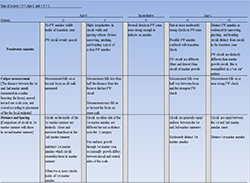Images by Area
Southeast Alaska
Last modified on Feb 21, 2019
Origins of Chinook salmon caught in southeast Alaska waters include Alaska, British Columbia, and the Pacific Northwest (Weitkamp 2010). Fish with these different origins have a range of life histories, including different freshwater ages and marine growth, which are apparent in scale patterns. The two main life history types found in the Pacific Northwest and southeast Alaska (Healey et al. 1991) are:
- Stream-type: After emergence, these fish spend a winter in fresh water before emigrating to the ocean in the spring and are freshwater age 1. These fish return to their natal river to spawn in the spring or summer, up to several months prior to spawning.
- Ocean-type: After emergence, these fish do not spend a winter in fresh water before emigrating to the ocean, thus their scales show freshwater age 0. These fish return to their natal river in the fall, a few days or weeks prior to spawning.
Stream-type is the dominant life history type for Chinook salmon populations north of the Nass River, BC, and ocean-type is the dominant life history type found south of the Nass River (Healey 1983). There are, however, exceptions such as the Situk River in Southeast Alaska being Ocean-type.
In addition to different amounts of time in fresh water, these two life histories show different marine distribution patterns (Koo 1967, Weitkamp 2010). Ocean-type Chinook salmon remain in estuarine waters for a period of days to several months. The majority grow to maturation in nearshore and coastal waters, generally do not go further than 1000 km from their natal river, and do not go far from shore (Healey et al. 1991). Stream-type Chinook salmon pass through estuarine waters to reside in coastal marine waters until late summer or autumn, and their ocean distribution is much broader and more offshore. By the end of autumn, most have migrated farther along the coast than ocean-type fish, as well as into the open ocean and Alaska Gyre waters (Healey et al. 1991). Recoveries of coded wire tagged hatchery and wild fish in coastal waters from southern California to the Bering Sea provide evidence for this directed migration and other behavioral differences (Weitkamp 2010).
As a consequence of the diversity of possible origins of Chinook salmon in southeast Alaska waters and a concern about the subjectivity of interpreting scale growth patterns, Rowse et al. (1990) developed a table of Freshwater Age Criteria (Figure 1) to use as guideline for freshwater age estimation. In general, three scale characteristics are scored and summed, and the sum of the points indicates a freshwater age of 1 or 0. The three scale characteristics include:
- Freshwater annulus presence;
- Caliper measurement, the position of the freshwater annulus relative to the first and second marine annuli; and
- Ocean circuli spacing, a comparison of marine circuli spacing during the first two years at sea.
Scale Images
Included are links to images of scales collected from Chinook salmon scales in the Unuk, Stikine, Taku, Chilkat rivers and tributaries:
- Unuk River and tributaries
- Stikine River and tributaries
- Taku River and tributaries
- Chilkat River and tributaries
References
Healey, M. 1983. Coastwide distribution and ocean migration patterns of stream-and ocean-type Chinook salmon, Oncorhynchus tshawytscha. Canadian field-naturalist:427-433.
Healey, M. 1991. Life history of chinook salmon (Oncorhynchus tshawytscha). Pages 311-394 in C. Groot, and L. Margolis, editors. Pacific salmon life histories.
Koo, T. 1967. Objective studies of scales of Columbia River Chinook salmon, Oncorhynchus tshawytscha (Walbaum). Fishery Bulletin 66(2): 165-180.
Rowse, M. L., C. W. Farrington, S. A. McPherson, N. J. Sands, and B. W. V. Alen. 1990. Chinook salmon ageing techniques. Alaska Department of Fish and Game Special Publication, Juneau.
Weitkamp, L. A. 2010. Marine distributions of Chinook salmon from the west coast of North America determined by coded wire tag recoveries. Transactions of the American Fisheries Society 139(1): 147-170.

